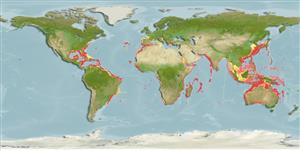Пластиножаберные (акулы и скаты) (sharks and rays) >
Hexanchiformes (Frill and cow sharks) >
Hexanchidae (Cow sharks)
Etymology: Hexanchus: hex (Gr.), six; anchus, etymology unclear, perhaps anchos (Gr.), choke or throttle, referring to how six gill openings of H. griseus extend down onto the throat (See ETYFish); nakamurai: In honor of Teng’s colleague Hiroshi Nakamura, Fisheries Experiment Station of the Government-General during the Japanese occupation of Taiwan, who illustrated this species as H. griseus in 1936 (See ETYFish).
Eponymy: Dr Hiroshi Nakamura was a Japanese ichthyologist. [...] (Ref. 128868), visit book page.
Environment: milieu / climate zone / depth range / distribution range
экология
морской батидемерсальный; пределы глубины 0 - 700 m (Ref. 125614), usually 90 - 600 m (Ref. 6574). Deep-water; 33°N - 36°S, 30°E - 178°W
Indo-West Pacific: patchily distributed in most warm-temperate and tropical seas.
Length at first maturity / Size / Вес / Возраст
Maturity: Lm ?, range 142 - ? cm
Max length : 206 cm TL самец/пол неопределен; (Ref. 130455)
позвонки: 155. This slender-bodied shark is readily distinguished from its larger congener (H. griseus) by having a narrower head, relatively larger eyes, 5 large lower comb-shaped anterolateral teeth, a long slender dorsal-caudal space, with distance from the dorsal origin to the upper caudal origin being at least twice the length of the dorsal fin base; with the upper and lower caudal postventral margins forming a strong arch. In life, Color of dorsum a uniform pale brown without a light line extending along the lateral body trunk, the trailing fin edges are white in some specimens and the ventral surface is lighter (Ref. 94780).
Found on continental and island shelves and slopes, occasionally near surface or inshore from 0 to 700 m depth. Feeds on small to medium-sized bony fishes and occassionally on crustaceans. Viviparous, with 13-26 young in a litter (Ref. 125614). Size at birth measures to about 40-43 cm TL (Ref. 94780). It is taken as bycatch within its range, but is not commercially important (Ref. 125614). Utilized for its fins, meat and liver oil but of little value due to its relatively small size (Ref. 58048).
Life cycle and mating behavior
половая зрелость | размножение | нерест | икра | Fecundity | личинки
Viviparous, with number of young 13 in one litter. Length at birth about 43 cm (Ref. 125614). Distinct pairing with embrace (Ref. 205).
Ebert, D.A., W.T. White and H.-H. Ho, 2013. Redescription of Hexanchus nakamurai Teng 1962, (Chondrichthyes: Hexanchiformes: Hexanchidae), with designation of a neotype. Zootaxa 3752(1):020-034. (Ref. 94780)
Статус Красного Списка МСОП (Ref. 130435: Version 2024-2)
Использование человеком
рыболовство: рыболовство как средство для существования
дополнительная информация
инструменты
Специальные отчеты
Скачать в формате XML
ресурсы в Интернет
Estimates based on models
Preferred temperature (Ref.
123201): 8.1 - 23.9, mean 14.4 °C (based on 1233 cells).
Phylogenetic diversity index (Ref.
82804): PD
50 = 0.8281 [Uniqueness, from 0.5 = low to 2.0 = high].
Bayesian length-weight: a=0.00240 (0.00101 - 0.00571), b=3.14 (2.93 - 3.35), in cm total length, based on LWR estimates for this (Sub)family-body shape (Ref.
93245).
Trophic level (Ref.
69278): 4.2 ±0.7 se; based on diet studies.
устойчивость к внешним воздействиям (Ref.
120179): очень низкий, минимальное время удвоения популяции более 14 лет (Fec = 13).
Fishing Vulnerability (Ref.
59153): Very high vulnerability (90 of 100).
